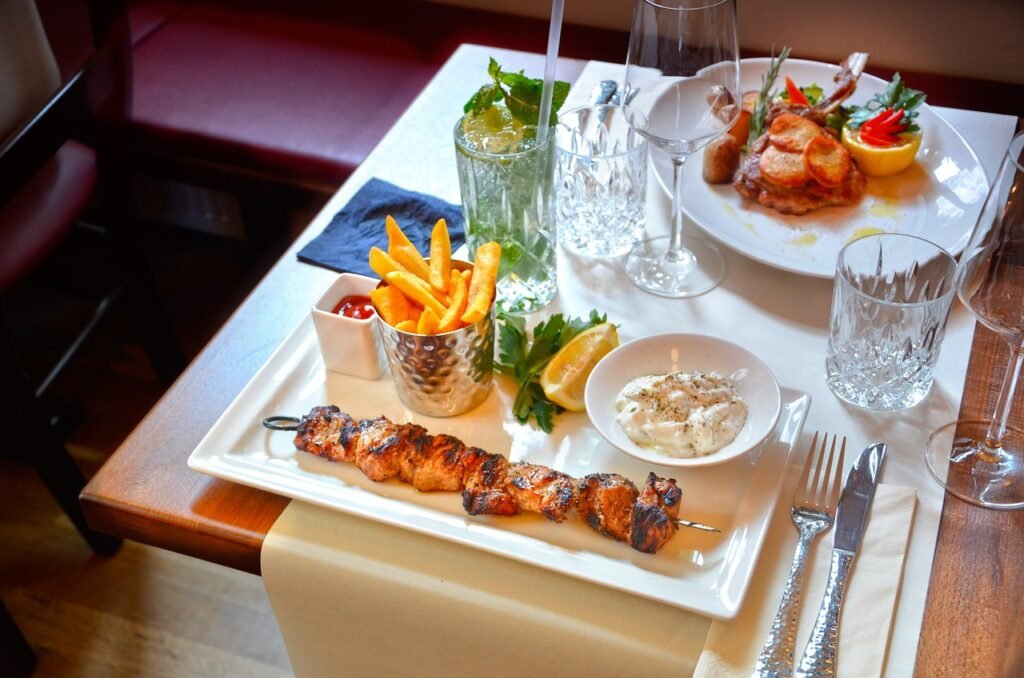
The world of culinary experiences is undergoing a fascinating transformation as gastronomy and mixology converge like never before. In 2024, dinner-inspired mixology has emerged as a captivating trend that combines the artistry of food with the creativity of cocktails. This intriguing fusion has given rise to a new wave of culinary-inspired mixology, where flavors, techniques, and presentations borrowed from the kitchen are brought to the bar.
In this article, we will delve into the exciting realm of dinner-inspired mixology, exploring the latest trends, unique ingredient combinations, the influence of culinary techniques, innovative garnishes, collaborations between chefs and mixologists, and the future developments that are shaping this evolving landscape. Get ready to embark on a tantalizing journey where the worlds of gastronomy and mixology intertwine to create an unforgettable dining experience.
1. Introduction: The convergence of gastronomy and mixology
The evolution of mixology and its connection to gastronomy
Mixology, the art of cocktail-making, has come a long way since its humble beginnings. It has evolved from a simple combination of spirits, mixers, and garnishes to a true culinary experience. This evolution has been driven by a growing appreciation for the art of mixology and its connection to the world of gastronomy. Just as chefs carefully curate flavors and textures in a dish, mixologists are now using their skills to create cocktails that harmoniously blend different ingredients and showcase unique flavor profiles.
The growing popularity of culinary-inspired cocktails
In recent years, we have witnessed a surge in the popularity of culinary-inspired cocktails. People are no longer satisfied with just a basic drink; they want a sensory experience that tantalizes their taste buds. As a result, mixologists are turning to the world of gastronomy for inspiration. The fusion of food and drink has become a trend that is taking the cocktail scene by storm, and it shows no signs of stopping.
2. Culinary-inspired cocktail trends in 2024

Exploring the flavors of savory cocktails
Gone are the days when cocktails were strictly sweet and fruity. In 2024, we’re seeing a rise in savory cocktails that push the boundaries of taste. Mixologists are incorporating ingredients like bacon, herbs, and spices to create complex and intriguing flavor combinations. These savory cocktails are a welcome departure from the ordinary and offer a refreshing alternative to traditional sweet concoctions.
Utilizing herbs and botanicals in mixology
Herbs and botanicals have long been used in cooking to enhance flavors, and now they’re making their way into cocktail glasses. Mixologists are experimenting with fresh herbs like basil, rosemary, and thyme, infusing their cocktails with a burst of aromatic goodness. Botanical elements such as flowers and roots are also finding their way into innovative cocktail creations. These herbaceous cocktails not only taste great, but they also add a touch of elegance to any drink menu.
Incorporating fermented ingredients in cocktails
Fermentation has been a buzzword in the culinary world for quite some time, and now it’s making its mark on mixology too. Fermented ingredients like kombucha, kefir, and kimchi are being utilized in cocktails to add depth and complexity to the flavors. The natural tanginess and effervescence of fermented ingredients bring a unique twist to traditional cocktail recipes, giving them a modern and avant-garde appeal.
3. The fusion of flavors: Exploring unique ingredient combinations
The art of balancing contrasting flavors in cocktails
Mixologists are no longer bound by traditional flavor pairings. They are boldly experimenting with contrasting flavors to create unexpected and delightful combinations. Sweet and spicy, sour and savory, bitter and fruity – these unlikely duos are coming together in perfect harmony to create cocktails that leave a lasting impression. The art of balancing these contrasting flavors is no easy feat, but when done right, it can result in a truly remarkable drinking experience.
Unconventional ingredient pairings that create harmonious flavors
Gone are the days of sticking to tried-and-true combinations. Mixologists are now venturing into uncharted territory, pairing ingredients that may seem unconventional at first but work together beautifully. From unexpected herbs and spices to exotic fruits and liquors, the possibilities for creating unique flavor combinations seem endless. These unconventional pairings bring excitement and intrigue to the world of mixology, challenging our taste buds and expanding our horizons.
4. Culinary techniques influencing mixology
Sous vide infusions and their impact on cocktail flavors
The culinary technique of sous vide has found its way into the world of mixology, giving rise to a new wave of flavor-infused cocktails. By vacuum-sealing ingredients and cooking them in a water bath at a precise temperature, mixologists are able to extract maximum flavors and infuse them into spirits.
This technique opens up a world of possibilities, allowing for the creation of cocktails with intense and concentrated flavors that would be otherwise impossible to achieve.
Molecular gastronomy techniques in cocktail creation
Molecular gastronomy, known for its scientific approach to cooking, has found a home in the realm of mixology as well. Mixologists are experimenting with techniques like foams, gels, and spherification to create visually stunning and innovative cocktails.
These techniques not only add a touch of theatricality to the drink-making process but also allow for new textures and flavor profiles to be explored. Molecular mixology is pushing the boundaries of what we thought was possible in a cocktail, making every sip a true adventure.
In the world of mixology, gastronomy is no longer just a source of inspiration – it’s become an integral part of the creative process. The rise of dinner-inspired mixology in 2024 is a testament to our ever-evolving tastes and our desire for unique and unforgettable culinary experiences. So, the next time you find yourself at a cocktail bar, prepare to embark on a journey where the line between food and drink becomes beautifully blurred. Cheers to the deliciously unexpected!

5. The art of food presentation in cocktails
Presentation is a crucial aspect of any gastronomic experience, and mixologists have taken note of this by emulating culinary plating techniques in cocktail presentation. Just like a beautifully arranged plate of food, cocktails now feature carefully placed elements that appeal to the eyes before they even touch your lips. From perfectly balanced layers to intricate garnishes, mixologists have mastered the art of turning a drink into a work of art.
Edible cocktail garnishes have also become a popular trend, adding both visual appeal and a burst of flavor to your drink. Think of a crisp cucumber slice floating delicately on the surface, or a zest of citrus bringing a tangy twist to your cocktail. These edible garnishes not only enhance the aesthetics of your drink but also provide an interactive element as you savor them alongside your sips.
6. The rise of experimental food-based garnishes
Gone are the days of the simple lemon wedge or maraschino cherry adorning your cocktail glass. The world of mixology has embraced experimentation with food-based garnishes, bringing a new level of creativity to the table. Dehydrated fruits and vegetables have become stars of the garnish game, adding unique textures and flavors to cocktails. Imagine a dehydrated strawberry slice delicately perched on the rim, infusing its sweet essence into each sip.
Edible flowers have also taken the garnish scene by storm, providing a touch of elegance and sophistication to cocktails. From vibrant pansies to delicate rose petals, these floral adornments not only look stunning but also add subtle floral notes that enhance the overall drinking experience. Mixologists are now tapping into the world of botany to uncover new and exciting edible flowers to charm both your taste buds and your Instagram feed.
7. Collaborations between chefs and mixologists
In the culinary world, collaborations between chefs and mixologists have become increasingly common and celebrated. Why keep the creativity limited to the kitchen or the bar when combining forces can result in truly extraordinary experiences? By working together, chefs and mixologists can create unique food and drink pairings that complement and elevate each other.
Mixologists are no longer confined to the bar; they are an integral part of the dining experience at restaurants. They play an essential role in crafting cocktails that harmonize with the flavors and profiles of the dishes, taking the concept of pairing to new heights. The integration of mixology into the dining experience adds an unexpected twist and encourages guests to explore the diverse possibilities of flavor combinations.
8. The future of dinner-inspired mixology: Anticipated developments and trends
As we peek into the future of dinner-inspired mixology, it’s clear that technology will play a significant role. We can anticipate the integration of innovative tools and techniques that will enhance the art of concocting cocktails. From molecular mixology to smart devices that precisely measure ingredients, technology will elevate the craft and push the boundaries of what is possible.
The world of mixology is a constantly evolving landscape, and we can expect to see emerging flavor profiles and ingredients in dinner-inspired mixology. Bartenders and mixologists will continue to experiment, incorporating exotic spices, herbs, and unexpected combinations to create unforgettable taste experiences.
With a growing interest in sustainability and health-conscious choices, we may also witness an emphasis on organic and locally sourced ingredients in cocktails.
The rise of dinner-inspired mixology is not just a passing fad but a movement that showcases the creativity and artistry behind the blending of culinary and mixology worlds. So, raise your glass and embrace this exciting trend that promises to tantalize your taste buds and delight your senses.
Cheers to the future of mixing gastronomy!In conclusion, the rise of dinner-inspired mixology in 2024 has introduced a whole new level of creativity and innovation to the world of cocktails. By infusing culinary techniques, flavors, and presentations into mixology, bartenders and chefs are pushing the boundaries of taste and sensory experiences.
The convergence of gastronomy and mixology has opened up a realm of possibilities, where cocktails are transformed into culinary masterpieces. As we look ahead, it is exciting to anticipate the future developments and trends that will continue to shape this dynamic field.
So raise your glass to the fusion of gastronomy and mixology, and get ready to be amazed by the ever-evolving world of dinner-inspired cocktails. Cheers to a deliciously thrilling journey!

FAQ
- What is dinner-inspired mixology?
Dinner-inspired mixology refers to the blending of elements from gastronomy and mixology to create innovative cocktails. It involves incorporating culinary techniques, flavors, and presentations into the art of cocktail-making, resulting in unique and immersive drinking experiences.
- How are culinary techniques influencing mixology?
Culinary techniques such as sous vide infusions and molecular gastronomy have found their way into the realm of mixology. These techniques allow mixologists to extract flavors, infuse ingredients, and create unique textures in cocktails, adding a new dimension to the overall drinking experience.
- What are some examples of food-based garnishes used in dinner-inspired mixology?
In dinner-inspired mixology, you can expect to see a range of experimental food-based garnishes. Examples include dehydrated fruits and vegetables, edible flowers, herbs, and even savory garnishes like bacon or miniature appetizers. These edible garnishes not only enhance the visual appeal of cocktails but also add an extra layer of flavor and aroma.
- How can collaborations between chefs and mixologists enhance the dining experience?
Collaborations between chefs and mixologists can greatly enhance the overall dining experience. By working together, they can curate food and cocktail pairings that complement and elevate each other, creating a harmonious fusion of flavors. This collaboration also opens doors to innovative techniques, ingredient combinations, and presentation styles, resulting in a truly immersive culinary journey for diners.

